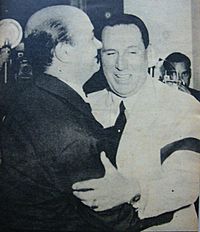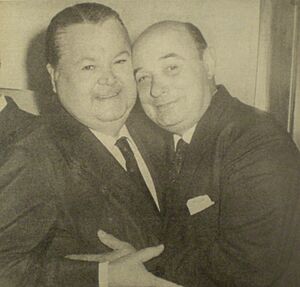Cátulo Castillo facts for kids
Quick facts for kids
Cátulo Castillo
|
|
|---|---|

Cátulo (left) with Juan Perón in 1953
|
|
| Background information | |
| Birth name | Ovidio Cátulo González Castillo |
| Born | 6 August 1906 Buenos Aires, Argentina |
| Died | 19 October 1975 (aged 69) |
| Genres | Tango |
| Occupation(s) | Poet, lyricist, composer |
Ovidio Cátulo González Castillo (born August 6, 1906 – died October 19, 1975) was a famous Argentine poet and composer. He wrote many well-known tango songs. Some of his most famous works include Tinta roja, El último café, and La última curda. One of his tangos, La calesita, even inspired a movie!
Cátulo's father, José González Castillo, had strong political ideas. Because of these ideas, Cátulo lived in Chile as a baby. His family returned to Argentina in 1913. Cátulo also held strong political beliefs later in his life.
Contents
Cátulo's Amazing Career
Cátulo wrote his first tango, Organito de la tarde, when he was just 17 years old. Besides music, he was also a talented boxer! He became the featherweight boxing champion in Argentina. He was even chosen to go to the Paris Olympics with his country's team.
In 1926, Cátulo traveled to Europe. There, he even led his own orchestra.
During the 1930s, he started teaching at the Municipal Conservatory of Manuel de Falla in Buenos Aires. By 1950, he became the director of this important music school. He stayed there until he retired.
In the 1940s and 1950s, tango music was very popular. Cátulo focused on writing poetry and songs. He worked with many famous composers. These included Mariano Mores, Osvaldo Pugliese, and Sebastián Piana. His most important partner after 1945 was Aníbal Troilo. Together, they created hits like María and La última curda.
Cátulo wrote for many newspapers and magazines. He also published a book called Danzas Argentinas in 1953. He composed music for several films. He also wrote a play called El Patio de la Morocha. He was both a secretary and president of SADAIC, which is an organization for authors and composers.
Facing Challenges
In 1953, Cátulo became the president of the National Commission of Culture. This was a very important role. However, two years later, a new government came to power. This government removed him from all his positions.
His wife, Amanda Pelufo, remembered those difficult times. She said they lost everything they had. Cátulo could no longer teach or lead SADAIC. He couldn't even collect money for his songs. Sometimes, his music was even banned from the radio.
During this tough period, Cátulo found new hobbies. He continued to write tangos. He also started painting in the style of Benito Quinquela Martín. Most importantly, he discovered a deep love for animals. His family ended up caring for many dogs, cats, and even two lambs!
Because of these political challenges, Cátulo had to stop working for a while. He was on a list of people who were not allowed to work. Many other tango artists faced similar problems. He could not return to his profession until the government changed.
Later Years and Legacy
In the 1960s, things became easier politically. Cátulo was able to return to his work. He kept composing new songs. He also wrote screenplays for movies. He continued to work with SADAIC.
He published a novel called Amalio Reyes, un hombre. This book later became a film. In 1971, he published Prostibulario, which included his letters with Juan Perón.
Some of his most popular songs from this time included:
- Maria
- El último café
- La última curda
- La Calesita
- Tinta roja
- Caserón de tejas
In 1974, Cátulo Castillo was honored as an Illustrious Citizen of Buenos Aires. When he received the award, he shared a short story. He spoke about an eagle and a worm reaching the top of a mountain. The eagle said, "You climbed here, I flew." This story made people think about how they achieve their goals.
Passing Away
Cátulo Castillo passed away on October 19, 1975, from a heart attack. He left behind a rich legacy of tango music and poetry.
Film Work
Cátulo Castillo contributed to many films.
As Author
- El patio de la morocha (1951)
- La calesita (1963)
- Amalio Reyes, un hombre (1970)
- Perón, sinfonía del sentimiento (1999)
As Music Composer
- Internado (1935)
- Juan Moreira (1936)
- Los muchachos se divierten (1940)
- Arrabalera (1950)
For Soundtracks
- Ayúdame a vivir (1936)
- Eclipse de sol (1942)
- Buenos Aires a la vista (1950)
- Vivir un instante (1951)
- La muerte flota en el río (1956)
- Últimas imágenes del naufragio (1989)
For Texts
- Ésta es mi Argentina (1974)
See also
 In Spanish: Cátulo Castillo para niños
In Spanish: Cátulo Castillo para niños


